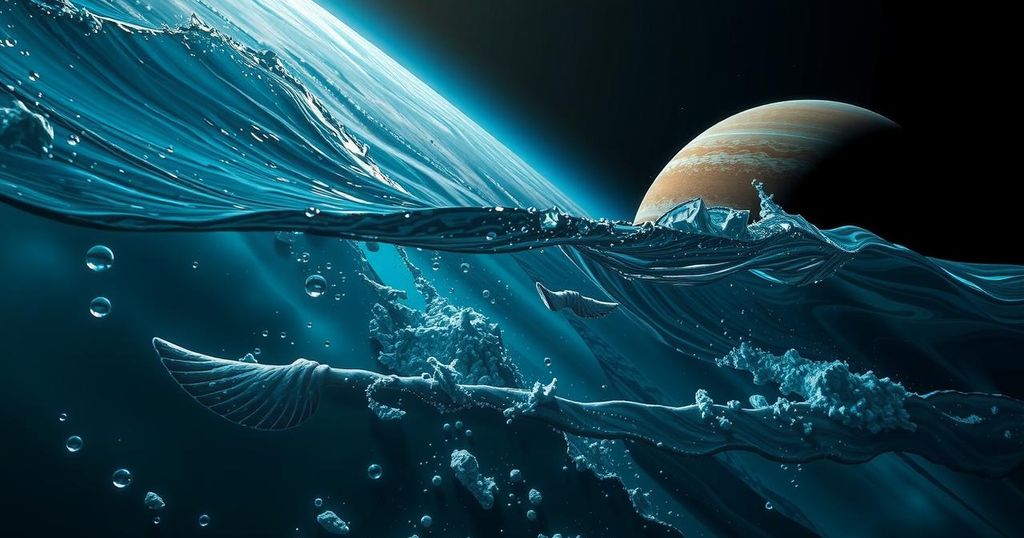Science
ADAM MASTERS, ARCHAEOLOGY, ASSOCIATION OF UNIVERSITIES FOR RESEARCH IN ASTRONOMY, BU, CLIMATE CHANGE, ENVIRONMENTAL IMPACT, EUROPE, FOSSILS, HEIDI HAMMEL, IMPERIAL COLLEGE, IMPERIAL COLLEGE LONDON, JONATHAN O ’ CALLAGHAN, JUPITER, LONDON, NASA, NATIONAL ACADEMY OF SCIENCES, NEPTUNE, NORTH AMERICA, SCIENCE, SPACE EXPLORATION, TIMES, UNITED KINGDOM, UNITED STATES, UNIVERSITY OF, UNIVERSITY OF CALIFORNIA, URANUS
Rajesh Choudhury
0 Comments
Unveiling the Secrets of Uranus and Neptune’s Hidden Oceans
Recent simulations suggest that both Uranus and Neptune may hide vast oceans of water beneath their thick atmospheres. This potential discovery could explain the unusual magnetic fields of these worlds, which significantly differ from those of other planets in our solar system. The findings were published by Burkhard Militzer in the Proceedings of the National Academy of Sciences, shedding new light on the ice giants’ mysterious interiors.
In the enigmatic realms of our solar system, where the icy giants Uranus and Neptune reside, a revolutionary idea emerges: vast hidden oceans may lie beneath their chilling surfaces. A recent study led by Burkhard Militzer, a planetary scientist from UC Berkeley, proposes that beneath the thick atmospheres of these planets exists a significant layer of water—about 5,000 miles deep. This discovery could elucidate the peculiar behaviors of their magnetic fields, which defy the norms established by Earth and its gas giant cousins.
The unusual magnetic fields of Uranus and Neptune, marked by their tilts and offsets, puzzled scientists for decades. They diverge from the orderly dipole patterns we see in Earth’s magnetic field, which resembles a giant bar magnet. Adam Masters of Imperial College London highlighted the long-standing mystery of these planets’ interiors, stating, “We didn’t really know anything before.” This newfound hypothesis opens doors to understanding the ice giants in a way previously thought unimaginable.
Dr. Militzer’s findings, detailed in the Proceedings of the National Academy of Sciences, stem from sophisticated simulations where he and his team modeled the behavior of 500 atoms within these icy bodies. The results suggest that the motions of water, likely in a liquid state, could be responsible for the chaotic magnetic fields, as evidenced by Voyager 2’s groundbreaking observations during its flybys in the 1980s. As these spacecraft traveled through space, they uncovered peculiarities about the magnetic environments of both planets that still spark intrigue today.
In an age where cosmic mysteries abound, this study shines a light on the chilling potential that Uranus and Neptune harbor oceans unseen by the human eye. Their hydrous depths may contain secrets that rewrite our understanding of planetary formation and magnetic genesis, cementing their status as more than mere icy worlds but as celestial playgrounds with untold stories waiting to unfold. As we peer deeper into the cosmos, each revelation brings us one step closer to understanding our universe’s wondrous complexities.
Uranus and Neptune, two of the outer planets in our solar system, are often referred to as ice giants, characterized by their cold temperatures and unique atmospheric compositions. Historically, the mechanisms driving their unusual magnetic fields have puzzled astronomers and planetary scientists, as they do not conform to typical models, especially when compared to Earth and the gas giants Jupiter and Saturn. NASA’s Voyager missions provided invaluable insights, but they left many questions unanswered about the inner workings of these distant worlds. Recent efforts have focused on modern simulations that explore the intricate details of their interiors, leading to astonishing hypotheses, such as the presence of massive ocean layers.
The compelling evidence from Dr. Militzer’s modeling suggests that Uranus and Neptune could hold vast, deep oceans of water beneath their icy surfaces, possibly responsible for their unique magnetic behaviors. As scientists continue to explore these icy realms, the potential for significant discoveries increases, reshaping our understanding of these enigmatic planets and perhaps revealing the nature of planetary evolution across the cosmos.
Original Source: www.nytimes.com




Post Comment